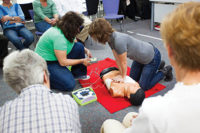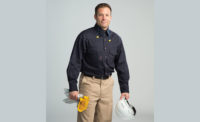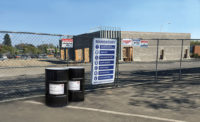Ashen colored, in distress
One day in February 2004, I was summoned from a meeting to the factory floor where our company builds computers. An employee who repairs customer computer units for warranty and handles other responsibilities was ashen colored and in distress. Only 47 years old then, he had no sign of heart disease although his cholesterol and other blood lipid counts were high. He looked to me like he needed to take a ride in an ambulance. After telling me he didn’t want to go to the hospital, he passed out and fell forward into my arms.As a former assistant fire chief, CPR instructor and emergency medicine teacher, I knew what to do. I had the employee’s supervisor call 9-1-1 and with the help of my brother-in-law, who also works for the company, got him down on the floor to begin CPR. I sent a colleague for the Medtronic LIFEPAK 500 AED, and he rushed it to the man’s side, where I had already cleared his airway and begun CPR. It took about one minute from the time the employee was on the ground to the time I could provide defibrillation. Initially, the AED’s audio prompt said “no shock advised.†I continued performing CPR because he was not breathing and had no pulse.
After a few additional seconds of CPR, the LIFEPAK 500 AED indicated the time was right for defibrillation. I wasted no time figuring out how to operate the AED, because it was so simple to use. It’s a very easy machine to fire up. You just follow the pictures, icons and voice prompts. The AED is designed to automatically analyze the heart’s rhythm and to give a shock if a lethal rhythm is detected. It takes a lot of responsibility off you.
The AED told me to shock the employee and then shock him again. When we hit him with the second shock, he woke up. By the time the emergency medical services (EMS) squad arrived 15 minutes later, he was already conscious with a strong blood pressure and pulse. Thanks to the AED, his fellow employees saved his life.
A matter of time
Sudden cardiac arrest is a leading cause of death in this country, claiming the lives of 335,000 people every year, including men, women and children. Most people (about 95 percent) don’t survive sudden cardiac arrest. Calling 9-1-1 and CPR are not enough. Survival rates drop up by about 7–10 percent every minute without defibrillation. According to OSHA, SCA causes 13 percent of all workplace deaths. Thanks to the availability of AEDs and their ease of use, it doesn’t have to be this way.The American Heart Association recommends defibrillation within five minutes of arrest or even sooner. When you consider that it takes most emergency medical services teams 6–12 minutes to arrive, it’s obvious why time is a serious concern. Plus, not all first responders are equipped with an AED.
Although not everyone can survive sudden cardiac arrest, survival rates can be dramatically improved with effective AED programs. Studies show that having an effective AED program in place and a defibrillation shock delivered within three minutes of collapse can increase survival rates to 74 percent.
In August 2003, the American College of Occupational and Environmental Medicine (ACOEM) surveyed 400 of its members working in major corporations and found that 34 percent of those who have implemented an AED program have used their AED at least once. The survey also showed that 66 percent of victims of SCA in the workplace were successfully revived.
Push for a plan
The idea for our program began with Paul Sullenberger, a former deputy chief of police for the city of Piqua, who became aware of AEDs when there was a push to get them into police cruisers. In his first two days on the job, they had six calls for ambulances. That spurred Paul to decide we needed an AED, because it took 14 minutes on average to get an ambulance to the company. One time it took 27 minutes.So he and I decided to talk to the director of human resources at the time about getting an AED at Systemax. She was worried that people might play with the AED, abuse the unit or use it incorrectly. Paul told her there was virtually no possibility of using it incorrectly, and that it is extremely easy to use. The AED analyzes the heartbeat, and the rescuer reads and follows the diagrams and voice prompts.
In a subsequent meeting with a company vice president to make our case, it took just a few minutes for him to see the purpose. The only question he asked was why two AEDs were necessary. We answered that since our company has two buildings, having an AED in each could save precious minutes in accessing the defibrillator if needed. The vice president’s perspective? If you use the AED once it has paid for itself.
At the ready
When this sudden cardiac arrest occurred, I was the only person in the company who knew how to use the AED. Now more than 30 employees are trained. We deliberately scheduled one class on February 13, the anniversary of the event. The location and function of the two AEDs are part of new employee orientation. Everyone who works here knows where to find an AED. Our AEDs are at the ready in case one of our 250 employees or a visitor to our facility should suffer sudden cardiac arrest.Our employees are our company’s most valuable asset. Our two AEDs, one for each of our company’s buildings, are another line of defense in emergency medical situations. You don’t want to lose an employee because of a preventable situation. Thanks to the foresight of our company management, the LIFEPAK 500 AED and the quick response of fellow coworkers, our employee is alive today. He’s living proof that AEDs save lives.


